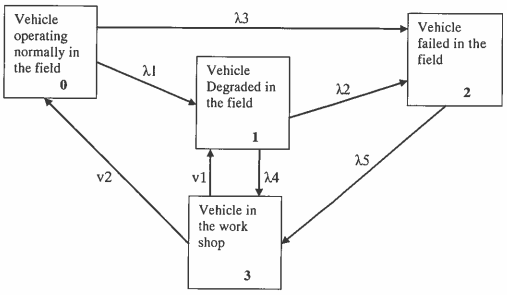1. The Weibull hazard rate function λ(t) is given by:
λ(t) = (β/θ)t
Where β is the shape parameter and θ is the scale parameter. Obtain an expression for a reliability function.
2. Assume load and capacity are exponentially and normally distributed, respectively. The mean load is equal to 14000psi and the values of the mean and standard deviation associated with the normal distribution are 21000 and 3000 psi respectively. Calculate the reliability.
3.
The following numbers of bends to failure were recorded for 20 paper clips:
11,29,15,20,19,11,12,9,9,8,13,20,11,22,20,9,25,19,11 and 10.
A. Make a nonparametric plot of R(t), the reliability.
B. Attempt to fit your data to Weibull and Normal Distributions then determine the parameters.
C. Briefly discuss your results.
4.
A device has a constant failure rate of 0.7/year.
A. What is the probability that the device will fail during the second year of operation.
B. If upon failure the device is immediately replaced, what is the probability that there will be more than one failure in 3 years operation?
5.
There exists a nuclear reactor plant with a system to deliver emergency cooling with 2 pumps and 4 valves. In the event of an accident the protection system delivers an actuation signal to the two identical pumps and the 4 identical valves. The pumps start up, the valves open and the liquid coolant is delivered to the reactor. The following failure probabilities are found to be significant:
P(ps)=10-5, the probability that the protection system will not deliver a signal to the pump and the valve actuators.
P(p)= 2 x 10-2, the probability that a pump will fail to start when the actuation signal is received.
P(v)= 10-1, the probability that a valve will fail to open when the actuation signal is received.
P(r) =0.5 x 10-5, the probability that the reservoir will be empty at the time of the accident.
A) Draw a fault tree for the failure of the system to deliver any coolant to the primary system in the event of an accident.
B) Evaluate the probability that such a failure will take place in the event of an accident.
1. There is a contractual requirement to demonstrate with 90% confidence that a vehicle can achieve a 100-km mission with a reliability of 99%. The acceptance test is performed by running 10 vehicles over a 50,000-km test track.
(a). What is the contractual MTTF? Assuming an exponential distribution:
(b). What is the maximum number of failures that can be experienced on the demonstration test without violating the contractual requirement? (Note: Assume an exponential distribution.)
2. The failure rate for a high-speed fan is given by Mt) = (2 x 104 + 3 x 10-60 / hr, Where t is in hours of operation. The required design-life reliability is 0.95.
(a) How many hours of operation should the design life be?
(b) If, by preventive maintenance, the wear contribution to the failure rate can be eliminated, to how many hours can the design life be extended?
(c) By placing the fan in a controlled environment, we can reduce the contribution of random failure to Mt) by a factor of two. Then, without preventive maintenance, to how many hours may the design life be extended?
(d) What is the extended design life with both preventive maintenance and controlled environment?
3. The following table gives a series of times to repair (man-hours) obtained for a diesel engine.
|
11.6
|
7.9
|
27.7
|
17.8
|
8.9
|
22.5
|
|
3.3
|
33.3
|
75.3
|
9.4
|
28.5
|
5.4
|
|
10.3
|
1.1
|
7.8
|
41.9
|
13.3
|
5.3
|
(a) Estimate the MTTR.
(b) Estimate the repair rate and its 90% confidence interval assuming that the data is exponentially distributed.
4. Set up the associated Markov differential equations for the following system.
λ3= Failure rate from State-0 to State-2
λ4= Failure rate from State-I to State-3
λ5= Failure rate from State-2 to State-3
v1= Repair rate from State-3 to State-I
v2= Repair rate from State-3 to State-0
